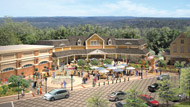|
COVER STORY, FEBRUARY 2010
MID-ATLANTIC MARKET PICKING UP
Brokers hope for regional turnaround in 2010.
Jon Ross
Retail in the Mid-Atlantic region is interconnected. When weighing the current state of the market and the chances for retail recovery in 2010, it’s best to view the region as a whole and not just as the sum of its more significant parts — Baltimore and Washington, D.C. Many brokers from Baltimore also focus on doing deals in D.C., and the same is true with real estate wheelers and dealers in Virginia. These brokers are familiar with the retail challenges throughout the mid-Atlantic, and when talking about one city, they can easily talk about overarching themes in the entire region.
 |
Fair Hill in Olney, Maryland.
|
|
In the Mid-Atlantic, there is hope for the future through expansion. D.C. is experiencing some growth — albeit slow growth — around the Nationals stadium, and Wegman’s has taken some new locations in Baltimore. Carl M. Freeman Companies is currently working to restructure Olney Town Center in Olney, Maryland, as a 110,000-square-foot grocery-anchored center called Fair Hill. The project, which is set to deliver during the fall of 2010, will be anchored by a 52,940-square-foot Harris Teeter. The big development talk in the Mid-Atlantic, however, is about the Metropolitan Washington Airports Authority’s work to expand its D.C. Metrorail service to Tysons Corner, Virginia. To be completed in the next 3 years, the development will help spur massive retail growth in the area, creating new shopping districts and restaurants around the Metro stop.
“We will see a tremendous boom as Tysons Corner will be made over,” says Arthur Nachman of Fairfax, Virginia-based Long & Foster Commercial/TCN Worldwide. “There will be a huge redevelopment that occurs there.” Nachman, who has seen preliminary development plans, envisions new buildings sprouting up where one and two-story properties once stood. The land will be expensive, so car dealers and other traditionally horizontal retailers will go vertical, building their stores toward the sky.
“We’re in a little bit of a blip right now because of the construction of the Silver line. That is having a pause,” he says, noting that the retail market will be cooler as long as construction is going on. But he’s excited about the future. “We are going to see multi-use buildings with retail, office and residential components,” he says. “We’re going to see a more pedestrian-friendly type Corner. The makeover that we saw in Boston in the courthouse and Virginia Square area, we’re going to see, but even to a much higher level.”
Malls, specialty retailers and power centers are experiencing good sales numbers throughout Northern Virginia. On the other hand, there has been a decrease in strip shopping activity. There also isn’t as much activity from mom-and-pop retailers as Nachman was seeing 3 or 4 years ago. He attributes this to capital availability. The tenants who are expanding — mid- to large-sized companies — have access to funding. But these retailers aren’t necessarily going into areas of the region flush with empty space, so vacancy rates have been slow to decline.
“The places that have the lowest vacancy rates still get the most interest,” Nachman says. “It sounds somewhat counterintuitive. You would think they would be looking to go into places where there was lower cost of space, but that’s not necessarily the case. They want to go where there is the highest traffic, and they want to go to the places that are the highest income.”
The Baltimore and Washington suburbs have been experiencing some increased retail activity, both in transactions and leases. Dennis Bodley, vice president of the retail division at Baltimore-based Hearn Burkley, says things have picked up in both areas during the past 5 months. Local and national tenants have started making deals and are backfilling vacant space. “The small tenants, I think that they’re feeling that the worst is over,” he says. “Sales declined, but their sales are starting to stabilize. It gives people confidence that they’ll get better, and they can move forward and open some new locations.”
Before that, the retail industry was in dire straits. Consumers were not spending money, the financial industry was in tatters and buyers, sellers, landlords and tenants were worried. “In the summer/fall of 2008, it was almost like people tore our signs down; nobody was calling,” he says.
From a landlord’s perspective, the market had been very good for a number of years. With a low vacancy rate and escalating rents, it was a very good market. “Then we had the recession, and vacancies and rents started going down, so it took some amount of time for the bid-ask spread to tighten up,” Bodley says. “It took time for landlords to come to the conclusion that some of these deals that they were presented with, even though the rents weren’t where they thought they should be, they said ‘OK, we should go ahead and do these deals. It may take longer than we think for the market to come back strongly.’”
“From what I’m hearing, virtually no one is planning on a quick turnaround, but there seems to be somewhat of a consensus that the worst is over,” he says, adding that most people he talks with say the market it bouncing along the bottom. “Which sounds kind of dismal,” Bodley says, “but bouncing along the bottom is a heck of a lot better than a continued freefall. My feeling is things will be better by the end of the year. The picture will look a bit better, but incrementally better.”
©2010 France Publications, Inc. Duplication
or reproduction of this article not permitted without authorization
from France Publications, Inc. For information on reprints
of this article contact Barbara
Sherer at (630) 554-6054.
|
